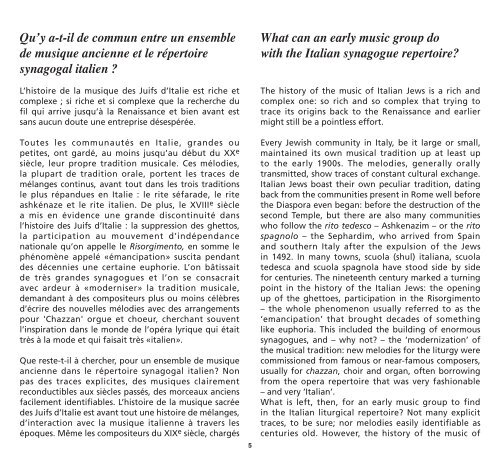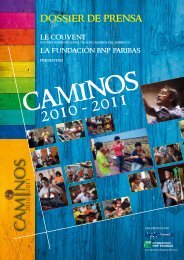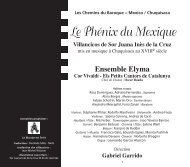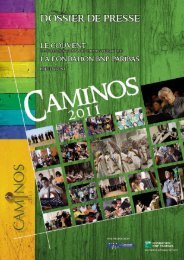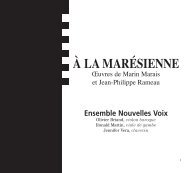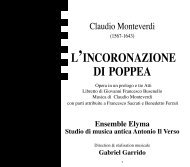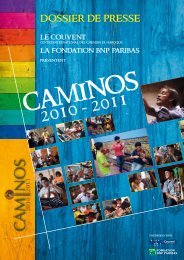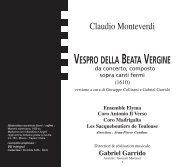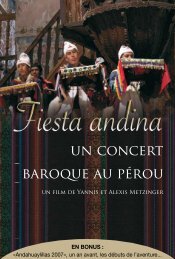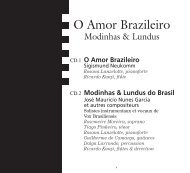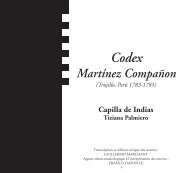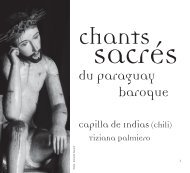Musique et poésie des Juifs en Italie à la Renaissance Music and ...
Musique et poésie des Juifs en Italie à la Renaissance Music and ...
Musique et poésie des Juifs en Italie à la Renaissance Music and ...
- No tags were found...
You also want an ePaper? Increase the reach of your titles
YUMPU automatically turns print PDFs into web optimized ePapers that Google loves.
Qu’y a-t-il de commun <strong>en</strong>tre un <strong>en</strong>semblede musique anci<strong>en</strong>ne <strong>et</strong> le répertoiresynagogal itali<strong>en</strong> ?L’histoire de <strong>la</strong> musique <strong>des</strong> <strong>Juifs</strong> d’<strong>Italie</strong> est riche <strong>et</strong>complexe ; si riche <strong>et</strong> si complexe que <strong>la</strong> recherche dufil qui arrive jusqu’à <strong>la</strong> R<strong>en</strong>aissance <strong>et</strong> bi<strong>en</strong> avant estsans aucun doute une <strong>en</strong>treprise désespérée.What can an early music group dowith the Italian synagogue repertoire?The history of the music of Italian Jews is a rich <strong>and</strong>complex one: so rich <strong>and</strong> so complex that trying totrace its origins back to the R<strong>en</strong>aissance <strong>and</strong> earliermight still be a pointless effort.Toutes les communautés <strong>en</strong> <strong>Italie</strong>, gran<strong>des</strong> oup<strong>et</strong>ites, ont gardé, au moins jusqu’au début du XX esiècle, leur propre tradition musicale. Ces mélodies,<strong>la</strong> plupart de tradition orale, port<strong>en</strong>t les traces demé<strong>la</strong>nges continus, avant tout dans les trois traditionsle plus rép<strong>and</strong>ues <strong>en</strong> <strong>Italie</strong> : le rite séfarade, le riteashkénaze <strong>et</strong> le rite itali<strong>en</strong>. De plus, le XVIII e sièclea mis <strong>en</strong> évid<strong>en</strong>ce une gr<strong>and</strong>e discontinuité dansl’histoire <strong>des</strong> <strong>Juifs</strong> d’<strong>Italie</strong> : <strong>la</strong> suppression <strong>des</strong> gh<strong>et</strong>tos,<strong>la</strong> participation au mouvem<strong>en</strong>t d’indép<strong>en</strong>danc<strong>en</strong>ationale qu’on appelle le Risorgim<strong>en</strong>to, <strong>en</strong> somme lephénomène appelé «émancipation» suscita p<strong>en</strong>dant<strong>des</strong> déc<strong>en</strong>nies une certaine euphorie. L’on bâtissaitde très gran<strong>des</strong> synagogues <strong>et</strong> l’on se consacraitavec ardeur à «moderniser» <strong>la</strong> tradition musicale,dem<strong>and</strong>ant à <strong>des</strong> compositeurs plus ou moins célèbresd’écrire <strong>des</strong> nouvelles mélodies avec <strong>des</strong> arrangem<strong>en</strong>tspour 'Chazzan' orgue <strong>et</strong> choeur, cherchant souv<strong>en</strong>tl’inspiration dans le monde de l’opéra lyrique qui étaittrès à <strong>la</strong> mode <strong>et</strong> qui faisait très «itali<strong>en</strong>».Que reste-t-il à chercher, pour un <strong>en</strong>semble de musiqueanci<strong>en</strong>ne dans le répertoire synagogal itali<strong>en</strong>? Nonpas <strong>des</strong> traces explicites, <strong>des</strong> musiques c<strong>la</strong>irem<strong>en</strong>treconductibles aux siècles passés, <strong>des</strong> morceaux anci<strong>en</strong>sfacilem<strong>en</strong>t id<strong>en</strong>tifiables. L’histoire de <strong>la</strong> musique sacrée<strong>des</strong> <strong>Juifs</strong> d’<strong>Italie</strong> est avant tout une histoire de mé<strong>la</strong>nges,d’interaction avec <strong>la</strong> musique itali<strong>en</strong>ne à travers lesépoques. Même les compositeurs du XIX e siècle, chargés5Every Jewish community in Italy, be it <strong>la</strong>rge or small,maintained its own musical tradition up at least upto the early 1900s. The melodies, g<strong>en</strong>erally orallytransmitted, show traces of constant cultural exchange.Italian Jews boast their own peculiar tradition, datingback from the communities pres<strong>en</strong>t in Rome well befor<strong>et</strong>he Diaspora ev<strong>en</strong> began: before the <strong>des</strong>truction of thesecond Temple, but there are also many communitieswho follow the rito te<strong>des</strong>co – Ashk<strong>en</strong>azim – or the ritospagnolo – the Sephardim, who arrived from Spain<strong>and</strong> southern Italy after the expulsion of the Jewsin 1492. In many towns, scuo<strong>la</strong> (shul) italiana, scuo<strong>la</strong>te<strong>des</strong>ca <strong>and</strong> scuo<strong>la</strong> spagno<strong>la</strong> have stood side by sidefor c<strong>en</strong>turies. The nin<strong>et</strong>e<strong>en</strong>th c<strong>en</strong>tury marked a turningpoint in the history of the Italian Jews: the op<strong>en</strong>ingup of the gh<strong>et</strong>toes, participation in the Risorgim<strong>en</strong>to– the whole ph<strong>en</strong>om<strong>en</strong>on usually referred to as the‘emancipation’ that brought deca<strong>des</strong> of som<strong>et</strong>hinglike euphoria. This included the building of <strong>en</strong>ormoussynagogues, <strong>and</strong> – why not? – the ‘modernization’ ofthe musical tradition: new melodies for the liturgy werecommissioned from famous or near-famous composers,usually for chazzan, choir <strong>and</strong> organ, oft<strong>en</strong> borrowingfrom the opera repertoire that was very fashionable– <strong>and</strong> very ‘Italian’.What is left, th<strong>en</strong>, for an early music group to findin the Italian liturgical repertoire? Not many explicittraces, to be sure; nor melodies easily id<strong>en</strong>tifiable asc<strong>en</strong>turies old. However, the history of the music of


